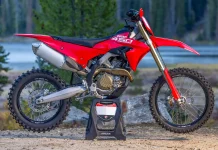
High-Tech Classic
After a six-year leave from the highway, Kawasaki is reentering the full-dress touring market with the technologically forward, nostalgically styled, 2009 Voyager. Kawasaki is touting their new Vulcan 1700 series as a bellwether for the company’s future in the cruiser segment, and the reimagined Voyager has been commissioned as their cruise line’s luxe flagship.
With its long-stroke 1700cc V-twin engine and bulging ’60s muscle car styling riffs, the 1700 Voyager resembles a husky American cousin of the inline four Voyager XII that vanished over the horizon in 2003. The Voyager’s new Occidental wardrobe is the visual hook in Kawasaki’s strategy to develop a motorcycle that it hopes will exploit a void left by the competition-namely, a high-tech metric V-twin powered, full-dress cruiser.
The touring segment’s current growth trajectory defies the gravity of the motorcycle industry’s overall sales decline, and Kawasaki sees disposable income in them thar saddlebags. The company is betting that a muscular new mile-eater on the showroom floor will bolster its immunity against the downturn. Development of the Vulcan 1700 series (which also includes the familiar Classic, Classic LT and Nomad) was a top-down effort, initially focusing on the Voyager.
The Voyager’s old look/new tech fusion certainly succeeds at the curb. Gone and (in most quarters) unlamented are the pointy angles, concealed engine, boxy saddlebags and Denny’s booster-seat passenger perch of the XII. The resurrected Voyager takes its styling cues from LBJ-era Detroit, with an obvious and unavoidable nod to Milwaukee. The classically curvilinear fairing is frame-mounted, thus transferring air pressure to the chassis, rather than the handlebars. The bulwark’s no-frills headlamp and auxiliary lights enhance its vintage good looks. Adding some function to the form are the adjustable air vents on the lower fairing leg shields. The 5.3-gallon tank tucks itself unobtrusively under the lip of the saddle and is topped with a broad chrome strip.
The dual ten-gallon saddlebags are elegantly rounded and capacious, but the latches can be finicky. For those whose junk requires a trunk, Kawasaki provides. The sleek 13.2-gallon chest doesn’t look as though it could contain two full-face helmets, but in they go without complaint. Touring riders asked for bright taillights and, again, Kawasaki took heed. In addition to the V-shaped fender-mounted LED taillight, the trunk houses a wide, dual-strip LED tail/stoplight, mounted high and bright on the bike’s posterior. Up front, chunky 45mm forks pin a 16-inch, 130mm Bridgestone Exedra radial, with a 16-inch 170 bringing up the rear.
Kawasaki crafted the new 1700 mill partly in response to customer demand for a step-up from the 1600. Based loosely on the hulking Vulcan 2000, the new 1700 substitutes SOHC, 4vpc architecture for the 2000’s traditional pushrod design. A single pin crank accentuates the low-end V-twin pulse, while twin counterbalancers police the vibrations.
Kawasaki claims that the new powerplant delivers 108 ft/lbs of torque at a punctual 2750 rpm on the Voyager. That figure represents a 15-percent advantage over the 1600. Kawasaki is not reluctant to boast that, along with the additional 100 cubes, the 1700 enjoys a 20-percent increase in horsepower, which peaks at 5000 revs.
To administer the Voyager’s brawn, Kawasaki has developed its first fully Electronic Throttle Valve system (ETV). Working with a fuel injection system based on those found in the Ninja 650R and Vulcan 900, the ETV enables the ECU to control spark, air and fuel input, while adjusting for throttle position, temperature, air pressure and load.
The throttle pulley remains cable-actuated, allowing for familiar resistance at the grip. The ETV converts that analog input into a precise digital response, resulting in easy starting, improved fuel economy and lower emissions. Kawasaki is quick to assure those of us who have retained a healthy techno-skepticism, along with our eyebrow ridges, that we may drop the clubs and emerge from caves; the ETV is monitored by an onboard diagnostic system, which will default to one of three fail-safe modes in the event of component failure, while allowing the engine to continue running. Along with the Nomad, the Voyager’s ETV incorporates cruise control in the top four gears.
Kawasaki is understandably proud of its new V-twin, and has framed the bike’s sculpted fins and liquid-cooled upper cylinders for maximum visibility within the Voyager’s curvaceous bodywork. The new powerplant is part of an arranged marriage with Kawasaki’s new six-speed transmission, which houses not one, but two overdrive gears. The entire Vulcan line has dropped the shaft and now transfers power to the rear wheel via a svelte belt. The 28mm carbon fiber strip is not only much lighter than the old shaft-driven arrangement, but transmits power more efficiently, and looks much cooler in the process.
Shoehorning this newly developed hardware and technology into an existing chassis design would be akin to lugging your MacBook Air around in a Ralphs bag. Kawasaki has developed a new single backbone, double cradle frame for the 1700 line that is 40-percent more rigid and sheds 4.4 pounds off the retired 1600 version. To increase maneuverability, the new chassis is more compact-the wheelbase has been shortened to 65.6 inches, while rake has been shaved two clicks to 30 degrees.
Rider ergonomics have been tightened, and the compressed rider triangle is immediately noticeable, in a good way. The floorboards are elevated and forward, while the handlebars demand a shorter reach than most big baggers. It all amounts to a very natural upright position with the big, scooped 28.7-inch seat providing enough resistance to my lower back. The windscreen just tops the average rider’s eye line and is distortion free. The result proves comfortable from the time you knock back the kickstand in the morning to the time you knock back a beer at sunset.
Settling into the big touring saddle and pulling the 886-pounder upright (add nine pounds for the ABS model), the muscle car flashback resumes. As soon as I glanced at the cockpit with its big, chrome-bezeled gauges, I was reminded that I have a ’65 Mustang in the garage, patiently awaiting restoration. The lone hint of modernity is the LCD multi-function display sandwiched between the dials. The screen displays a gear indicator, clock and warning lights, in addition to a dual mode odo/tripmeter and fuel monitor.
Likewise, the audio head unit is a hybrid of old and new dashboard aesthetics. The intercom headset-capable system includes an FM/AM/WX radio and is compatible with MP3 players, an XM radio tuner and, for those early adopters, CB radio. The head unit is tucked under the cockpit gauges, but can be operated by a controller on the left handlebar.
The snug ergos and compact steering geometry contribute to the Voyager’s respectable low-speed dexterity. After a few tight boots-on-the-boards U-turns, I had to get off the bike and reexamine its visual heft. The big Vulcan grew more dexterous as I heel/toe shifted through the gears. The new transmission is smooth and clunkless with light, progressive effort at the clutch. Additionally, Kawasaki’s exclusive Positive Neutral Finder eliminates the need to fumble with the shifter until the "N" light materializes while the bike is stopped.
Kawasaki engineers obviously labored to find a balance between disorderly big-twin conduct and a composed, touring temperament. The Voyager delivers a manly counterbalanced engine pulse, which complements the glottal thwapp heaved from the big slash-cut pipes. In fifth and sixth gears, vibes are politely damped for endurance.
Scrambling through lazy farmland sweepers at a cow-tipping pace, I leaned on third and fourth gears almost exclusively. The rare meat is at the center of the steak, and there is enough power and range in the two middle cogs for almost any non-highway situation. Because the Voyager’s hefty front end feels more securely planted than those of its Vulcan cousins, I was able to angle the big fairing over farther than I expected.
Kawasaki has mated the bike’s nimble new frame with tour-ready suspension. In addition to the 45mm Showa’s with a lanky 5.5 inches of travel up front, the swingarm sports twin air shocks with 3 inches of travel and adjustable rebound damping. The default setting is configured for a rider weighing 150 pounds, so most of us will be adding some air to the equation for maximum wrinkle reduction.
The standard Voyager features adequately muscular stopping power; four-piston calipers put the bite on dual 300mm platters up front, with a single 300mm disc hauling down the rear. While that familiar setup proved reassuring in every circumstance I encountered, Kawasaki’s Advanced Coactive Braking Technology (K-ACT) ABS option-available exclusively on the Voyager-is a welcome addition to a luxury touring bike pushing 900 pounds.
While the K-ACT system translates rider input into balanced braking force, it should not be confused with standard linked braking systems. Responding to input from pressure and speed sensors, the brake ECU controls the motor-driven hydraulic pumps, which deliver the proper amount of pressure to the brake calipers. Clamp down on the right hand lever, rear brake pedal, or both, and the system will engage and apply progressive, measured stopping power to both front and rear brakes, preventing lock-up.
The system is designed to feel natural to the rider, delivering a small pulse to the lever and pedal to indicate its activity. The K-ACT system does not engage below 12 mph, and the ABS is clipped below 4 mph. Still, it required a hefty squeeze for me to get the system to activate. When it did, it responded as advertised. It does, however, take a bit of getting used to being able to grab a handful of front brake without the nose attempting to bury itself in the blacktop. A Kawasaki rep noted that most of their cruiser and touring riders prefer the standard braking setup, but riders stepping up to a bigger mount will find K-ACT to be a worthwhile investment.
With a flick of the turn signal onto the highway, the Voyager reveals the flipside of its personality-a halcyon wayfarer with iPod connectivity. Dropping into the overdriven fifth and sixth gears, engaging the cruise control and cranking up the tunes, offers some distinctly civilized long-haul pleasure.
Highway gears offer smooth power delivery and a muted engine pulse in place of the roll-on acceleration found in the lower cogs. For the average-sized rider, the bike’s compact ergonomics are comfortable over extended touring time, though lankier pilots may long for some extra leg-stretch. Passenger accommodations include floorboards and a curved trunk-mounted backrest that also provides arm support.
The Voyager’s ETV’s cruise control function is accessed from the right handlebar and can be engaged between 30 and 85 mph in the top three gears. Once the desired speed is set, it can be raised or lowered in single mph increments. The system can be overridden by throttle, brake or clutch input.
Equally intuitive, is the Voyager’s audio unit. The three-band system is accessed via the left handlebar and can fully control an iPod through its cockpit display. The two-speaker system is upgradeable, allowing the addition of rear speakers. Audiophiles will be quick to swap out hardware. At highway speeds, everything from Chet Baker to Bad Religion became aural tinfoil when cranked to an audible volume. The Voyager also features inputs for navigation devices, heated clothing and other roadgoing gadgetry. No word at press time regarding Xbox or karaoke machine connectivity.
Kawasaki will be rolling out an extensive accessory catalog with some familiar accoutrements including pillow top gel seats, trunk racks, saddlebag trim, and trunk liners, in addition to audio and intercom accessories.
There will be those who succumb to the new-look Voyager’s American Beauty, just as there will certainly exist a stalwart core of loyalists who mourn for the old in-line four’s angular allure. Both camps will find common ground in the new edition’s lithe handling, abundant brawn, and tech-appeal. The 2009 Kawasaki Vulcan Voyager 1700 is certain to spark a vigorous debate and many a bon voyage.
Photos by Adam Campbell





